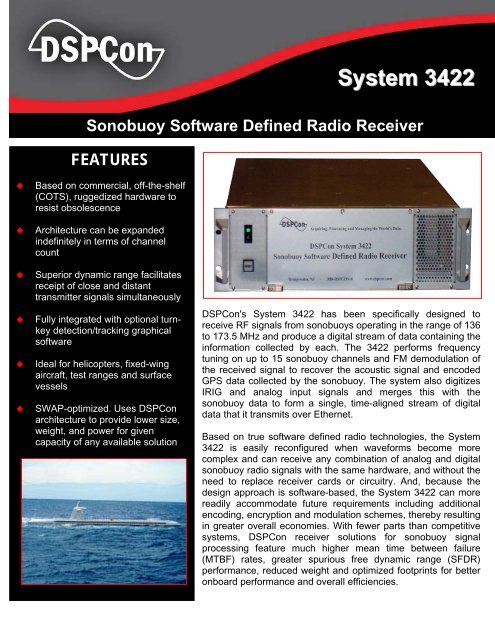You also want an ePaper? Increase the reach of your titles
YUMPU automatically turns print PDFs into web optimized ePapers that Google loves.
FEATURES<br />
<strong>System</strong> <strong>3422</strong><br />
Sonobuoy Software Defined Radio Receiver<br />
<br />
<br />
<br />
<br />
<br />
<br />
Based on commercial, off-the-shelf<br />
(COTS), ruggedized hardware to<br />
resist obsolescence<br />
Architecture can be expanded<br />
indefinitely in terms of channel<br />
count<br />
Superior dynamic range facilitates<br />
receipt of close and distant<br />
transmitter signals simultaneously<br />
Fully integrated with optional turnkey<br />
detection/tracking graphical<br />
software<br />
Ideal for helicopters, fixed-wing<br />
aircraft, test ranges and surface<br />
vessels<br />
SWAP-optimized. Uses DSPCon<br />
architecture to provide lower size,<br />
weight, and power for given<br />
capacity of any available solution<br />
DSPCon's <strong>System</strong> <strong>3422</strong> has been specifically designed to<br />
receive RF signals from sonobuoys operating in the range of 136<br />
to 173.5 MHz and produce a digital stream of data containing the<br />
information collected by each. The <strong>3422</strong> performs frequency<br />
tuning on up to 15 sonobuoy channels and FM demodulation of<br />
the received signal to recover the acoustic signal and encoded<br />
GPS data collected by the sonobuoy. The system also digitizes<br />
IRIG and analog input signals and merges this with the<br />
sonobuoy data to form a single, time-aligned stream of digital<br />
data that it transmits over Ethernet.<br />
Based on true software defined radio technologies, the <strong>System</strong><br />
<strong>3422</strong> is easily reconfigured when waveforms become more<br />
complex and can receive any combination of analog and digital<br />
sonobuoy radio signals with the same hardware, and without the<br />
need to replace receiver cards or circuitry. And, because the<br />
design approach is software-based, the <strong>System</strong> <strong>3422</strong> can more<br />
readily accommodate future requirements including additional<br />
encoding, encryption and modulation schemes, thereby resulting<br />
in greater overall economies. With fewer parts than competitive<br />
systems, DSPCon receiver solutions for sonobuoy signal<br />
processing feature much higher mean time between failure<br />
(MTBF) rates, greater spurious free dynamic range (SFDR)<br />
performance, reduced weight and optimized footprints for better<br />
onboard performance and overall efficiencies.
<strong>System</strong> <strong>3422</strong><br />
RF Input<br />
G bit Ethernet<br />
BNC DB-9 RJ45<br />
BNC (8) BNC<br />
IRIG-B and 7 Audio Inputs<br />
10 MHz Reference Clock<br />
Gnd<br />
Lug<br />
90-264VAC @ 47-440Hz<br />
splitter<br />
IF Inputs<br />
Trigger<br />
98.304 MHz Clock<br />
291.4 MHz Filter,<br />
AIS Crystal Notch Filter<br />
for<br />
Channels 1 and 99<br />
Protection<br />
10<br />
MHz<br />
Ref<br />
Input<br />
27dB<br />
Gain<br />
87dB<br />
Gain<br />
CH1 CH2 SYNC CLK<br />
DSPCon<br />
BRD-7131PMC-100<br />
16-channel<br />
Narrowband DDR<br />
DSPCon<br />
BRD-PMC-16AI64SSA-<br />
32-256K-I<br />
16 Channel A/D<br />
PMC Module<br />
Ethernet<br />
DSPCon<br />
RS-232<br />
BRD-MVME6100E-0173<br />
G4 Power PC Baseboard<br />
128 kHz Clock<br />
RF<br />
Down Converter<br />
130 MHz Down<br />
(154 MHz to 24 MHz) V M E B U S<br />
Ch 3<br />
Ch 2<br />
Ch 4<br />
Ch1<br />
Out Out<br />
Out<br />
In<br />
DSPCon<br />
BRD-9711VME-03<br />
2-channel, Low-Jitter<br />
Frequency Synthesizer<br />
Gnd<br />
3U VME Chassis<br />
+12V<br />
VME chassis power supply<br />
Chassis<br />
Ground<br />
Analog Specifications<br />
• Simultaneously receives and processes up to 15 sonobuoy channel plus IRIG-B data<br />
• Control: Ethernet or Mil-Std-1553<br />
• Output Sampling Rate: 128,000 samples/sec<br />
• IF Bandwidth (adjustable): 306/260/130 kHz<br />
• Audio Bandwidth: 48 kHz<br />
• Input Frequency: 136- 174 MHz<br />
• AIS Blocking Filter: (160.9375 – 162.4375 MHz) & UHF Uplink Filter (for 291.4 MHz)<br />
• Demodulation Schemes: FM, FSK, PSK, GMSK (GQPSK)<br />
• Non-harmonic SFDR: 70 dB (typical)<br />
• Time Alignment between Sonobuoy Audio Data and Analog Channels: 10 microseconds<br />
• Front-end Receiver Sensitivity: 0.7 microvolt (-110dBm)<br />
• Dynamic Range (combined RF amplifier and ADC): 120 dB<br />
• Processing Capability: 1.3 GHz Power Pc Plus Virtex-2 per 16 channels<br />
• Signal Support: ESM, Voice, DICASS & Time Code<br />
• Output: Ethernet, 1553 and/or Analog Out<br />
• Stanag 4283 Output Data Specification Compliance<br />
Environmental Specifications<br />
• Operating Temperature: +5° C - +45° C<br />
• Non-operating Temperature: +0° C - +60° C<br />
• Relative Humidity: < 90% (non-condensing)<br />
• Size: 19” W x 15.75” D x 5.25” H (17.5” D w/rack handles)<br />
• Weight: 28.35 lbs.<br />
• Power: 90-132/180-264 VAC auto-ranging; 47-440 Hz; 3 Amps (typical); 250 Watts (typical)

















